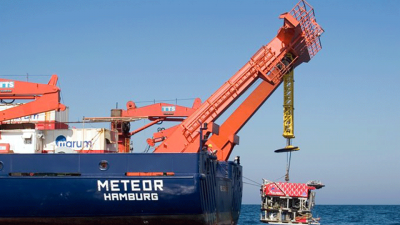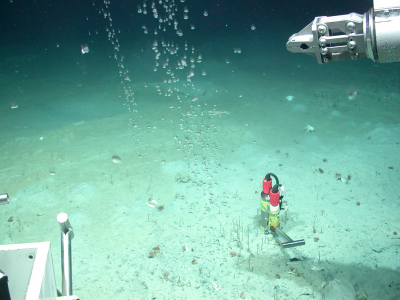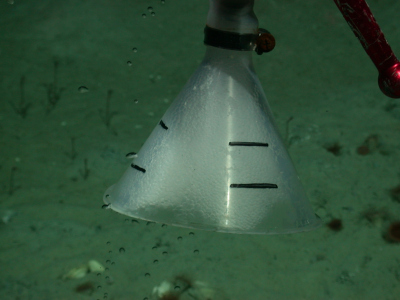Page path:
- Home
- Discover
- Media Releases
- Media Releases 2013
- 26-07-2013 Earthquakes: Yet Another Trigger of ...
Earthquakes: Yet Another Trigger of Greenhouse Gas Release
A team of scientists from the MARUM Institute at the University of Bremen, the Alfred Wegener Institute Helmholtz Centre for Polar and Marine Research in Bremerhaven, and the ETH Zürich investigated hydrocarbon cold seeps at the Pakistani continental margin. During their expedition with the research vessel METEOR the researchers extracted sediment core samples, which they closely investigated in the lab.
“First, we examined the pore water, which is the water between sediment grains in the core”, explains first author Dr. David Fischer from MARUM. “At two separate coring sites, one with hydrates the other without, we found unusual pore water sulfate profiles indicating a substantial increase in upward methane flux in the recent past.”
The presence of methane at shallower sediment depths was further corroborated by enrichments of the mineral barite at these depths. These barite enrichments were calculated to have started to form between 1916 and 1962. “Both the sulfate and the barite analyses indicated that in the recent past, something must have amplified the methane flux from below. We started going through the literature and found that a major earthquake had occurred close-by in 1945,” explains Fischer. “Based on several indicators, we postulated that the earthquake led to a fracturing of the sediments, releasing the gas that had been trapped below the hydrates into the ocean.”
The conservative estimate of the methane released since the earthquake, not taking into account how much was discharged directly after the quake, is equivalent to roughly 7.4 million cubic meters of methane gas at standard conditions at the earth’s surface, which equals ten large gas tankers. “There are probably even more sites in the area that had been affected by the earthquake”, says the MARUM scientist.
This study sheds light on yet another natural trigger of greenhouse gas release from marine sediments. In order to formulate more accurate estimates of the global carbon budget, all sources need to be accounted for. “The Intergovernmental Panel on Climate Change (IPCC) calculates the planet’s carbon budget by estimating all possible natural sources of carbon to the atmosphere, and we now provide a new mechanism of carbon export that had not been considered before,” explains Fischer.
More about methane:
Methane, consisting of hydrogen and carbon, is one of the most potent and active greenhouse gases; though less abundant in the atmosphere than carbon dioxide (CO2), it retains terrestrial infrared radiation more effectively than CO2. Methane can be found in the seafloor incorporated in gas hydrates. These are formed under low-temperature and high-pressure conditions and trap large amounts of methane limiting its release from the sediment into the water column, and eventually the atmosphere.
Publication:
Nature Geoscience 6/2013, 647-651:
Subduction zone earthquake as potential trigger of submarine hydrocarbon seepage
David Fischer(1), José M. Mogollón(2), Michael Strasser(3), Thomas Pape(1), Gerhard Bohrmann(1), Noemi Fekete(1), Volkhard Spiess(1), and Sabine Kasten(2)
(1)MARUM—Center for Marine Environmental Sciences, University of Bremen, Leobener Straße, D-28359 Bremen, Germany
(2)Alfred Wegener Institute Helmholtz Centre for Polar and Marine Research, Am Handelshafen 12, D-27570 Bremerhaven, Germany
(3)Geological Institute, ETH Zürich,Sonneggstraße 5, CH-8092 Zürich, Switzerland
More information / interviews / images:
Albert Gerdes
MARUM Public Relations
Tel. +49-421 – 218-65540
Email: [Bitte aktivieren Sie Javascript]
www.marum.de
https://twitter.com/marum_de
“First, we examined the pore water, which is the water between sediment grains in the core”, explains first author Dr. David Fischer from MARUM. “At two separate coring sites, one with hydrates the other without, we found unusual pore water sulfate profiles indicating a substantial increase in upward methane flux in the recent past.”
The presence of methane at shallower sediment depths was further corroborated by enrichments of the mineral barite at these depths. These barite enrichments were calculated to have started to form between 1916 and 1962. “Both the sulfate and the barite analyses indicated that in the recent past, something must have amplified the methane flux from below. We started going through the literature and found that a major earthquake had occurred close-by in 1945,” explains Fischer. “Based on several indicators, we postulated that the earthquake led to a fracturing of the sediments, releasing the gas that had been trapped below the hydrates into the ocean.”
The conservative estimate of the methane released since the earthquake, not taking into account how much was discharged directly after the quake, is equivalent to roughly 7.4 million cubic meters of methane gas at standard conditions at the earth’s surface, which equals ten large gas tankers. “There are probably even more sites in the area that had been affected by the earthquake”, says the MARUM scientist.
This study sheds light on yet another natural trigger of greenhouse gas release from marine sediments. In order to formulate more accurate estimates of the global carbon budget, all sources need to be accounted for. “The Intergovernmental Panel on Climate Change (IPCC) calculates the planet’s carbon budget by estimating all possible natural sources of carbon to the atmosphere, and we now provide a new mechanism of carbon export that had not been considered before,” explains Fischer.
More about methane:
Methane, consisting of hydrogen and carbon, is one of the most potent and active greenhouse gases; though less abundant in the atmosphere than carbon dioxide (CO2), it retains terrestrial infrared radiation more effectively than CO2. Methane can be found in the seafloor incorporated in gas hydrates. These are formed under low-temperature and high-pressure conditions and trap large amounts of methane limiting its release from the sediment into the water column, and eventually the atmosphere.
Publication:
Nature Geoscience 6/2013, 647-651:
Subduction zone earthquake as potential trigger of submarine hydrocarbon seepage
David Fischer(1), José M. Mogollón(2), Michael Strasser(3), Thomas Pape(1), Gerhard Bohrmann(1), Noemi Fekete(1), Volkhard Spiess(1), and Sabine Kasten(2)
(1)MARUM—Center for Marine Environmental Sciences, University of Bremen, Leobener Straße, D-28359 Bremen, Germany
(2)Alfred Wegener Institute Helmholtz Centre for Polar and Marine Research, Am Handelshafen 12, D-27570 Bremerhaven, Germany
(3)Geological Institute, ETH Zürich,Sonneggstraße 5, CH-8092 Zürich, Switzerland
More information / interviews / images:
Albert Gerdes
MARUM Public Relations
Tel. +49-421 – 218-65540
Email: [Bitte aktivieren Sie Javascript]
www.marum.de
https://twitter.com/marum_de
Dr. David Fischer, first author of the Nature Geoscience paper. Photo: Maya Schulte
The sea floor off the coast of Pakistan in 2,861 metres of water depth. Upper right: one of the manipulators of MARUM-QUEST. The diving vehicle has just deployed a temperature sensor (lower right) which produces temperature profiles of the sea floor.
Photo: MARUM, Universität Bremen
Photo: MARUM, Universität Bremen
A funnel is attached to one of the manipulators of the MARUM-QUEST. Methane bubbles are released from the sea floor and are being captured by the funnel. Within this device the gas becomes a solid substance: methane hydrate.
Photo: MARUM, University of Bremen
Photo: MARUM, University of Bremen






